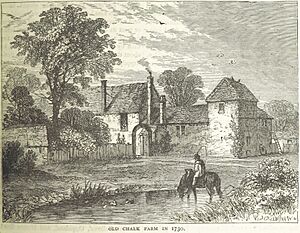Chalk Farm facts for kids
Quick facts for kids Chalk Farm |
|
|---|---|
 Junction of Adelaide Road and Haverstock Hill, outside Chalk Farm Underground station (1984) |
|
| Population | 24,977 Based on maximal two-ward definition based on 2011 census |
| OS grid reference | TQ2884 |
| London borough | |
| Ceremonial county | Greater London |
| Region | |
| Country | England |
| Sovereign state | United Kingdom |
| Post town | LONDON |
| Postcode district | NW1, NW3, NW5 |
| Dialling code | 020 |
| Police | Metropolitan |
| Fire | London |
| Ambulance | London |
| EU Parliament | London |
| UK Parliament |
|
| London Assembly |
|
Chalk Farm is a small area in north west London. It is located just north of Camden Town in the London Borough of Camden.
Contents
History
The Old Manor of Rugmere
Chalk Farm was once known as the Manor of Rugmere. This estate was first mentioned in the Domesday Book of 1086. The Domesday Book was a huge survey of England ordered by William the Conqueror. It helped him understand who owned what land and how much it was worth.
Rugmere was one of five estates that made up the large area of St Pancras. The name "Rugmere" probably meant "the Woodcock's Pool".
Later, King Henry VIII bought a part of this land. He used it to create the north-eastern section of what we now know as Regent's Park. The rest of the estate became known as Chalk Farm. Both parts remained within the St Pancras area.
In 1786, the estate was sold to Charles FitzRoy, 1st Baron Southampton. By then, it was already "commonly known as Chalk Farm".
Where Did the Name "Chalk Farm" Come From?
The name "Chalk Farm" is a bit of a mystery. It's not because the soil is chalky; the area is actually built on London Clay.
Most people think the name comes from an old English word. This word was Chaldecote or Caldecote. It meant "cold cottage" and was first used for this area in 1256. Over time, it changed to Chalcotts by the 1500s, and then simply Chalk by 1746.
The full name "Chalk Farm" appeared in the 1800s. There were also "Upper and Lower Chalcot Farms" nearby. Some people believe Chalk Farm was never called Chalcot. They think it was named for its farm buildings, which might have been painted with whitewash. Whitewash often contains chalk. The farmhouse at Lower Chalcot was even called the White House sometimes.
What's Chalk Farm Like?
Chalk Farm doesn't have exact borders. However, it was part of the old St Pancras area. The main part of Chalk Farm is between Chalk Farm Road to the east and the western edge of St Pancras. This area includes parts of Ainger Road and some of the Primrose Hill open space. The hill itself is actually in Hampstead.
Chalk Farm is part of the Camden Town with Primrose Hill area. It might also include parts of the Haverstock area. These local areas are sometimes called "wards".
Nearby Places
- Primrose Hill
- Camden Town
- Regent's Park
- Kentish Town
- Maitland Park
- St John's Wood
- Swiss Cottage
What Can You Do in Chalk Farm?
Chalk Farm is like the northern part of Camden Town. It has many fun places to visit. You can find lively pubs, places to listen to live music, and lots of restaurants.
Right near the tube station is The Roundhouse. This used to be a circular building for railway engines. Now, it's a cool place for arts and performances. You can see shows and events there.
Chalk Farm is also home to Haverstock School Business & Enterprise College. This school used to be called Haverstock Comprehensive School.
For many years, buses were kept and fixed at the Chalk Farm bus garage on Harmood Street. That garage is gone now. Today, two bus routes, the 27 and the 393, end their journeys at Chalk Farm. These buses go to different places outside central London.
If you love books, you might enjoy Walden Books. It's a long-standing secondhand bookshop located just off Chalk Farm Road.
Who Lives in Chalk Farm?
Chalk Farm is a place where many different kinds of people live. Some parts of the area have a mix of homes. This includes homes that are owned by people and homes that are rented. The area has a diverse community with people from all walks of life.
Getting Around Chalk Farm
The main way to get around Chalk Farm is by public transport.
The Chalk Farm Underground station is on the Northern line. This line runs north to south.
The nearest London Overground station is Kentish Town West. It is about 0.5 miles (0.8 km) to the east. The Overground trains run east to west.



